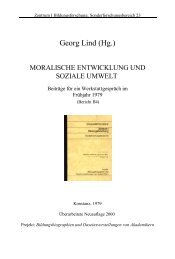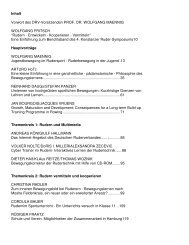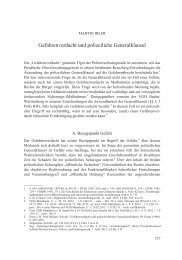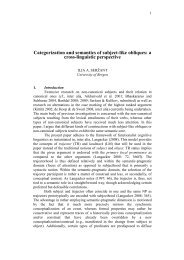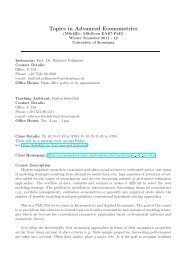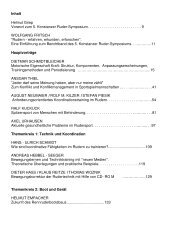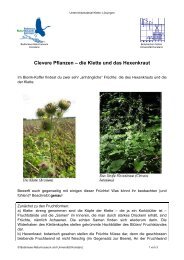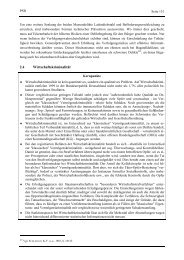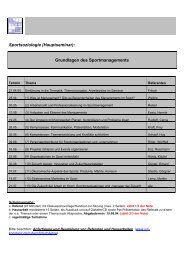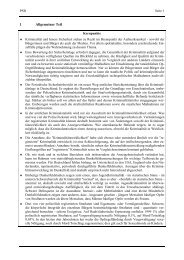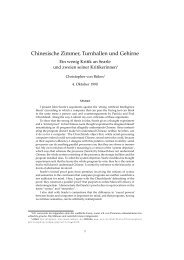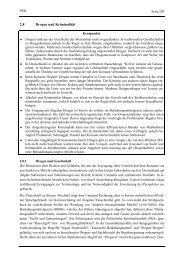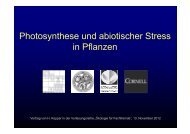Book of Abstracts Book of Abstracts - Universität Konstanz
Book of Abstracts Book of Abstracts - Universität Konstanz
Book of Abstracts Book of Abstracts - Universität Konstanz
Create successful ePaper yourself
Turn your PDF publications into a flip-book with our unique Google optimized e-Paper software.
B - 28<br />
68<br />
Femtosecond Laser-Induced Fusion <strong>of</strong> Fullerenes Inside Clusters<br />
Martin Hedén, Klavs Hansen, Eleanor E. B. Campbell<br />
Department <strong>of</strong> Physics, Göteborg University, SE-41296 Göteborg, Sweden<br />
The interaction <strong>of</strong> fullerene molecules with femtosecond laser radiation has been the subject<br />
<strong>of</strong> much interest in recent years. One interesting observation is the clear separation <strong>of</strong> different<br />
ionisation mechanisms that can be observed as a function <strong>of</strong> the timescale for the excitation [1].<br />
We have shown that for intermediate timescales (ca. 70-300 fs) the ionisation can be largely<br />
regarded as a thermal electron emission from the equilibrated hot electron system before energy<br />
is transferred to the nuclear degrees <strong>of</strong> freedom [2]. Interesting dynamics have also been<br />
observed in collisions between fullerenes leading to molecular fusion <strong>of</strong> the collision partners<br />
and the formation <strong>of</strong> a metastable larger fullerene that subsequently decays by the emission <strong>of</strong><br />
C2 molecules [3].<br />
In this contribution we combine these two topics <strong>of</strong> recent research interest and show that it is<br />
possible to induce molecular fusion <strong>of</strong> fullerenes that are weakly (van der Waals) bonded in<br />
molecular clusters. Fig. 1. Shows a typical mass spectrum <strong>of</strong> the clusters after laser irradiation.<br />
The fragmentation pattern is clearly reminiscent <strong>of</strong> C2 emission from a large fullerene-like<br />
structure. We show that this observation is consistent with our knowledge <strong>of</strong> both the ionisation<br />
mechanisms <strong>of</strong> C60 on irradiation with fs laser pulses and with our knowledge <strong>of</strong> the energetic<br />
threshold for fullerene fusion and the C2 decay <strong>of</strong> large fullerenes. It is shown that substantial<br />
atomic rearrangement can take place on a timescale shorter than that needed for the complete<br />
destruction <strong>of</strong> the highly excited cluster. This is different for the observations made in<br />
experiments where fullerene clusters are collided with highly charged ions [4]. Reasons for the<br />
difference will be discussed.<br />
N<br />
Figure 1. Time-<strong>of</strong>-flight mass spectrum from fullerene clusters after excitation with a 200 fs laser pulse.A distribution<br />
<strong>of</strong> fragment masses is seen corresponding to each cluster size, with a mass separation <strong>of</strong> the fragments in each<br />
distribution <strong>of</strong> C2. This is a clear indication that the clusters have ionised and then had time for extensive atomic<br />
rearrangement to form a single large fullerene-like structure before the original clusters completely disintegrate.<br />
References<br />
counts<br />
10000<br />
1000<br />
60 80 100 120 140 160 180 200 220 240 260 280 300<br />
[1] E.E.B. Campbell, K. Hansen, K. H<strong>of</strong>fmann, G. Korn, M. Tchaplyguine, M. Wittmann, I.V. Hertel,<br />
Phys. Rev. Lett., 84 2128 (2000)<br />
[2] K. Hansen, K. H<strong>of</strong>fmann, E.E.B. Campbell, J. Chem. Phys. 119 2513 (2003).<br />
[3] E.E.B. Campbell, A.V. Glotov, A. Lassesson, R.D. Levine, C.R. Physique 3 (2002) 341<br />
[4] B. Manil, L. Maunoury, B. A. Huber, J. Jensen, H. T. Schmidt, H. Zettergren, H. Cederquist, S.<br />
Tomita and P. Hvelplund, Phys. Rev. Lett. 21 (2003) 215504



